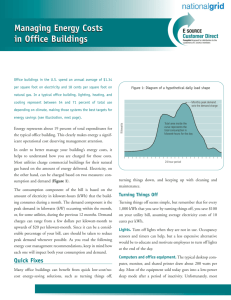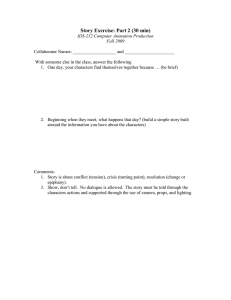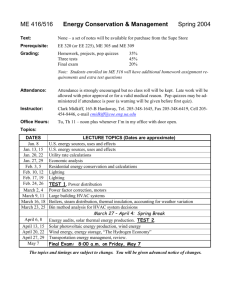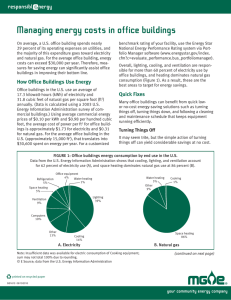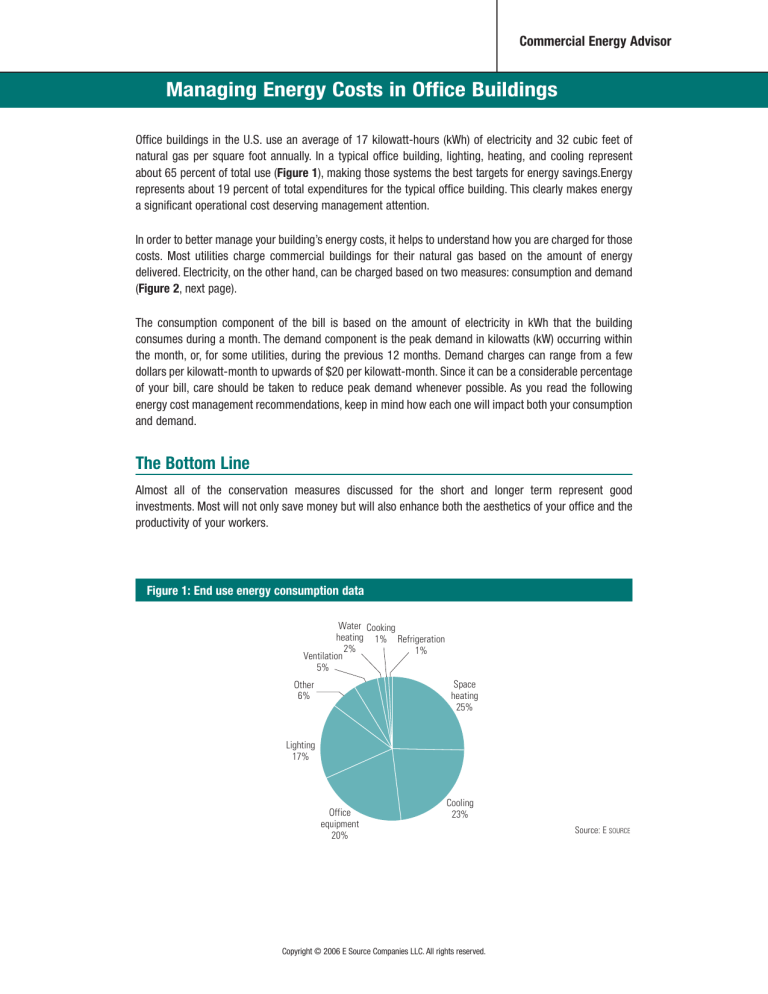
Commercial Energy Advisor Managing Energy Costs in Office Buildings Office buildings in the U.S. use an average of 17 kilowatt-hours (kWh) of electricity and 32 cubic feet of natural gas per square foot annually. In a typical office building, lighting, heating, and cooling represent about 65 percent of total use (Figure 1), making those systems the best targets for energy savings.Energy represents about 19 percent of total expenditures for the typical office building. This clearly makes energy a significant operational cost deserving management attention. In order to better manage your building’s energy costs, it helps to understand how you are charged for those costs. Most utilities charge commercial buildings for their natural gas based on the amount of energy delivered. Electricity, on the other hand, can be charged based on two measures: consumption and demand (Figure 2, next page). The consumption component of the bill is based on the amount of electricity in kWh that the building consumes during a month. The demand component is the peak demand in kilowatts (kW) occurring within the month, or, for some utilities, during the previous 12 months. Demand charges can range from a few dollars per kilowatt-month to upwards of $20 per kilowatt-month. Since it can be a considerable percentage of your bill, care should be taken to reduce peak demand whenever possible. As you read the following energy cost management recommendations, keep in mind how each one will impact both your consumption and demand. The Bottom Line Almost all of the conservation measures discussed for the short and longer term represent good investments. Most will not only save money but will also enhance both the aesthetics of your office and the productivity of your workers. Figure 1: End use energy consumption data Water Cooking heating 1% Refrigeration 2% 1% Ventilation 5% Space heating 25% Other 6% Lighting 17% Office equipment 20% Cooling 23% Copyright © 2006 E Source Companies LLC. All rights reserved. Source: E SOURCE Commercial Energy Advisor Figure 2: Diagram of a hypothetical daily load shape kW Monthly peak demand sets the demand charge Total area inside the curve represents the total kWh for the day 0 4 8 12 24-hour period 16 Notes: kW = kilowatt; kWh = kilowatt-hour. 20 24 Source: E SOURCE Quick Fixes Many office buildings can benefit from quick low-cost/no-cost energy-saving solutions, such as turning things off, turning things down, and keeping up with cleaning and maintenance. Turning Things Off Turning things off seems simple, but remember that for every 1,000 kWh that you save by turning things off, you save $100 on your utility bill, assuming average electricity costs of 10 cents per kWh. Lights. Turn off lights when they are not in use. Occupancy sensors and timers can help, but a less expensive alternative would be to educate and motivate employees to turn off lights at the end of the day. Computers and office equipment. The typical desktop computer, monitor, and shared printer draw about 200 watts per day. Most of the equipment sold today goes into a low-power sleep mode after a period of inactivity. Unfortunately, most users don’t take advantage of this feature. Making sure that these energysaving modes are enabled can produce significant energy savings. A single monitor draws about 100 watts per day; if left on overnight and on weekends, it could add $30 or more to the annual energy bill. Space heaters. Space heaters are energy hogs, drawing a kilowatt or more of power. As a first step, plug heaters into power strips controlled by occupancy sensors (other loads such as task lights and monitors can also be plugged into the power strips). Beyond that, recognize that the perceived need for individual space heating usually signals poor HVAC system control. Turning Things Down Some equipment cannot be turned off entirely, but turning it down to minimum levels where possible can save energy. Copyright © 2006 E Source Companies LLC. All rights reserved. Commercial Energy Advisor HVAC temperature setbacks. During closed hours, turn down temperature settings in warming seasons and up in cooling seasons. Common-area lighting. If possible, dim hallway lighting by 30 percent during daytime hours to reduce demand charges and energy consumption. Cleaning and Maintenance Making sure that your HVAC system is regularly cleaned and serviced can help to prevent costly heating and cooling bills. Check the economizer. Many air-conditioning systems use a dampered vent called an economizer that draws in cool outside air when it is available to reduce the need for mechanically cooled air. If not regularly checked, the linkage on the damper can seize up or break. An economizer stuck in the fully open position can add as much as 50 percent to a building’s annual energy bill by allowing hot air in during the airconditioning season and cold air in during the heating season. Have a licensed technician check, clean, and lubricate your economizer about once a year, and repair it if necessary. If the economizer is still operating, have the technician clean and lubricate the linkage and calibrate the controls. Check air-conditioning temperatures. With a thermometer, check the temperature of the return air going to your air conditioner and then check the temperature of the air coming out of the register that is nearest the air-conditioning unit. If the temperature difference is less than 14 degrees or more than 22 degrees, have a licensed technician inspect your air-conditioning unit. Change the filters. Filters should be changed on a monthly basis, and more often if you are located next to a highway, construction site, or other site where the air is dirtier than usual. Check the cabinet panels. On a quarterly basis, make sure the panels to your rooftop air-conditioning unit are fully attached, with all screws in place and all gaskets intact so that no air leaks out of the cabinet. Chilled air leaking out can cost $100 per rooftop unit per year in wasted energy. Clean the condenser coils. Check the condenser coils quarterly for either man-made or natural debris that can collect in them. At the beginning and end of the cooling season, thoroughly wash the coils. Check the airflow. Hold your hand up to the registers to ensure that there is adequate airflow. If there is little airflow, or dirt and dust are found in the register, have a technician inspect your unit and duct work. Longer-Term Solutions Longer-term solutions should also be considered. Although the actions covered in this section require more extensive implementation, they can dramatically increase the efficiency of your facility without compromising the working environment. Ask your local utility’s representative for more information about initiating such projects. Commissioning Commissioning is a process in which engineers check and tune up building systems to ensure that they are operating appropriately and efficiently. Studies have shown that continuously monitoring a building’s energy systems can lead to reductions of 10 to 15 percent in annual energy bills. For the typical 50,000-squarefoot office building, that’s equal to about $11,000 in savings per year! Savings typically come from resetting Copyright © 2006 E Source Companies LLC. All rights reserved. Commercial Energy Advisor existing controls to reduce HVAC waste while maintaining or even increasing comfort levels for occupants. Commissioning usually costs between 5 and 40 cents per square foot. Lighting Measures Fluorescent lamps. If your facility uses T12 fluorescent lamps, relamping with modern T8 lamps and electronic ballasts can reduce your lighting energy consumption by 35 percent. Adding specular reflectors, new lenses, and occupancy sensors or timers can double the savings. Paybacks of one to three years are common. Smart lighting design in parking lots. In its Lighting Handbook, the Illuminating Engineering Society of North America recommends parking lots be lit at an average of one foot-candle or less of light, but most parking lots are designed with far more lighting than that. Using lower-wattage bulbs can actually increase the safety of your lot: An overlit lot can be dangerous to drivers if their eyes cannot adjust quickly enough in the transition from highly lit to dark areas. When designing lighting for a new parking lot, consider using low-wattage metal halide lamps, instead of high-pressure sodium lamps, in fixtures that direct the light downward. Even with a lower wattage, an office building could safely use fewer lamps if this choice is made. Metal halide is less efficient than high-pressure sodium in conventional terms, but it puts out more light in the blue part of the spectrum, which turns out to be easier for our eyes to see under low-light conditions. Daylighting. Light shelves, installed high on the inside of a window, will shade and prevent glare in the bottom 6 feet of a floor, which is where most occupants work. The shelves also reflect the daylight up onto the ceiling, which indirectly illuminates a room. High-Efficiency HVAC Units A highly efficient packaged air-conditioning/heating unit can reduce cooling energy consumption by 10 percent or more over a standard-efficiency, commercial packaged unit. Select equipment that has multiple levels of capacity (compressor stages) with good part-load efficiency. Demand-Controlled Ventilation For office spaces that have large swings in occupancy, energy can be saved by decreasing the amount of ventilation supplied by the HVAC system during low-occupancy hours. A demand-controlled ventilation (DCV) system senses the level of carbon dioxide in the return air stream, uses it as an indicator of occupancy and decreases supply air when carbon dioxide levels are low. DCV systems are particularly applicable to variable occupancy spaces like indoor parking garages, auditoriums, meeting rooms, and cafeterias. Reflective Building Roof Coating If the roof needs recoating or painting, consider white or some other highly reflective color to minimize the amount of heat the building absorbs. This change can often reduce peak cooling demand by 15 to 20 percent. For a list of suitable reflective roof coating products, check out the U.S. Environmental Protection Agency’s Web site at www.energystar.gov/index.cfm?c=roof_prods.pr_roof_products. Copyright © 2006 E Source Companies LLC. All rights reserved.

